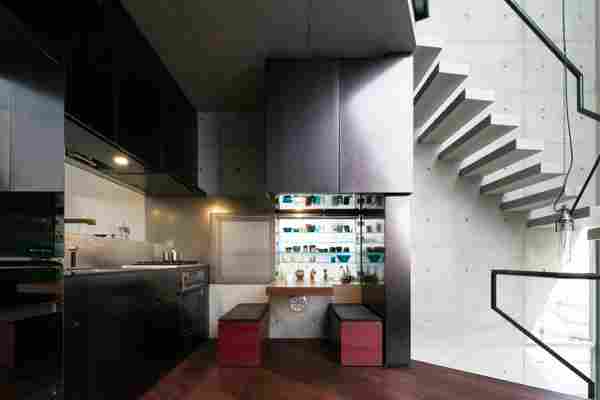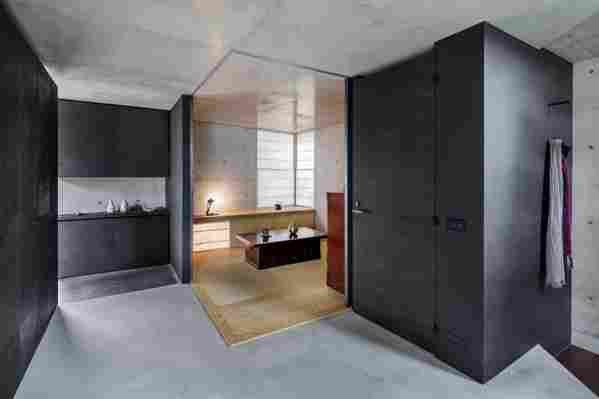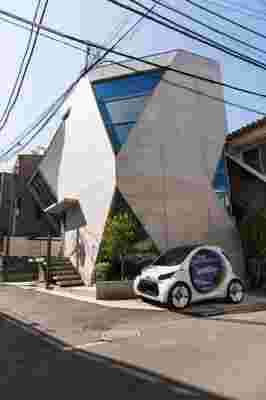The hardest part might be pinning down when exactly everything will occur, but from what we’ve just seen in Tokyo , the megacities of the future will be arriving sooner than we think. In some respects, the megacity may already be here: 200 m.p.h. Shinkansen bullet trains, LCD technology on the city’s ubiquitous vending machines, nuanced toilets that evoke fascination and wonder from visiting tourists—there’s simply a harmony with technology here that’s nonpareil. So what can we expect next?
We met up with Yasuhiro Yamashita, an award-winning architect who has completed more than 200 projects in Tokyo, the majority of them family homes. One especially notable work is R.Torso.C, a micro home that uses clever, sustainable building materials and maximizes a modest footprint. Yamashita sees the demand for these types of unique, individual homes growing as the population density continues to concentrate. An increasingly crucial factor is sustainability. To address that, Yamashita and the building team altered the makeup of traditional concrete.

An interior image of the The R.Torso.C.
“Sand is actually hard to come by in Japan, and it’s traditionally necessary to make concrete. But we have a lot of volcanic ash in the southern part of the country, and with this we made a special, better concrete,” Yamashita says. The new concrete is called shirasu, which employs the abundant volcanic ash in place of some of the sand mixture. This new mixture benefits from a pozzolanic reaction, which actually makes the concrete stronger and denser over time.
“This technique was used in ancient Rome and served the Pantheon for 2,000 years. And before this project, we were just disposing of the volcanic ash that we have here in Japan.” The architect also believes that developing clever building techniques in addition to materials will become more important than ever in future megacities.
“In Tokyo we don’t have many ways to connect with nature; there are buildings in every direction you look. But we can always look up.” Yamashita says the connection to the sky signals that there is something greater out there—it reminds you of the vastness of nature but has an added benefit, too. On R.Torso.C, the team pruned one of the top four corners of the building, creating a triangular cutout with a view to the sky. It changes the internal volume but most importantly creates a sense of depth and spaciousness in the four-story, 710-square-foot home. They brought in an environmental engineer to collaborate and create a “thermal circulation system” that keeps the temperature controlled.

A living area in the R.Torso.C.
Another trick is keeping a limited color palette. “Too many colors can make a space seem smaller. If you have one or two complementary colors, you can create a more open feeling.” Lastly, Yamashita and his team connected the stairs to the walls and only utilized a support pole. This also creates an openness and maximizes space (though it’s perhaps not ideal for toddler-proofing).
Another important part of daily life is getting around. While many of today’s methods such as public transportation and cars will still be doing the heavy lifting, those too will evolve. The world’s largest luxury automaker, Daimler—parent of Mercedes-Benz and Smart—believes what will be needed can best be summed up in an acronym the company has taken to heart: CASE. It stands for connected, autonomous, shared and service, and electric. Benz and Smart each recently showed off concepts they believe represent what future cars will look like in two different stages of the coming automotive evolution.

The autonomous Smart Vision EQ outside the R.Torso.C.
The Smart Vision EQ is a microcar concept that’s a bit further out. One glaring giveaway is the lack of a steering wheel or traditional foot pedals. By the time this car is on the roads, the idea is that we’ll be in Stage 5 of autonomous driving, where cars are fully capable of acting as transport pods. The Smart EQ would shuttle you from A to B while leaving you time to catch up on the news—on your phone or perhaps the digital screen on the dash—catchup on emails, or simply relax.
The car could be your personal ride, or an evolution of Smart’s Car2Go car-sharing service, which already has 2.6 million users worldwide and is expected to grow as more people eschew car ownership. Of course, the ride is electric, features inductive charging, and could even display the weather, time, or news while parked, for passersby. When architect Yamashita saw the Smart EQ, he immediately pointed out how both his micro home and the microcar attempt to create visual spaciousness within a limited footprint.
And while a Jetsonian car like that may be further down the line, the Mercedes-Benz EQ A will arrive much sooner. Benz is investing $10 billion in electromobility and says it will have ten new electric cars by 2022, with the first arriving as soon as 2019—less than two years from now. You can expect the latest and most inventive LED lighting, more digital screens in the cabin, a greater electric range than cars have today, and, of course, a compact size. In Tokyo there’s an appetite for the latest technology, which makes it an ideal candidate and the perfect incubator to test and eventually adopt these new megacity ways.
The Mercedes-Benz EQ A.
“There’s a technological optimism here that’s found in all aspects of culture, even down to anime,” says Edgar Pelaez, a Japanese subculture expert, living in Tokyo. As we walk through the Akihabara, the famed electronics district—also known as the heart of Japanese otaku (geek) culture and the place to obsess over video games, anime, and manga—Pelaez points out how this varies from the traditional notion in the West.
“You can see it in films such as 2001: A Space Odyssey , and the Terminator series. There’s an idea that technology will destroy us if too advanced. In Japan, it’s the opposite.” Pelaez says the embodiment of postwar Japan can best be seen in the famous Astro Boy comic. The idea is if you respect technology and AI, these robots or systems can be your friend; they can help and advance humanity. It’s humans that can corrupt technology or use it for ill purposes.
From micro homes to highly advanced cars, the next stage of the megacity is coming, and it may be here sooner than we think.

Leave a Reply